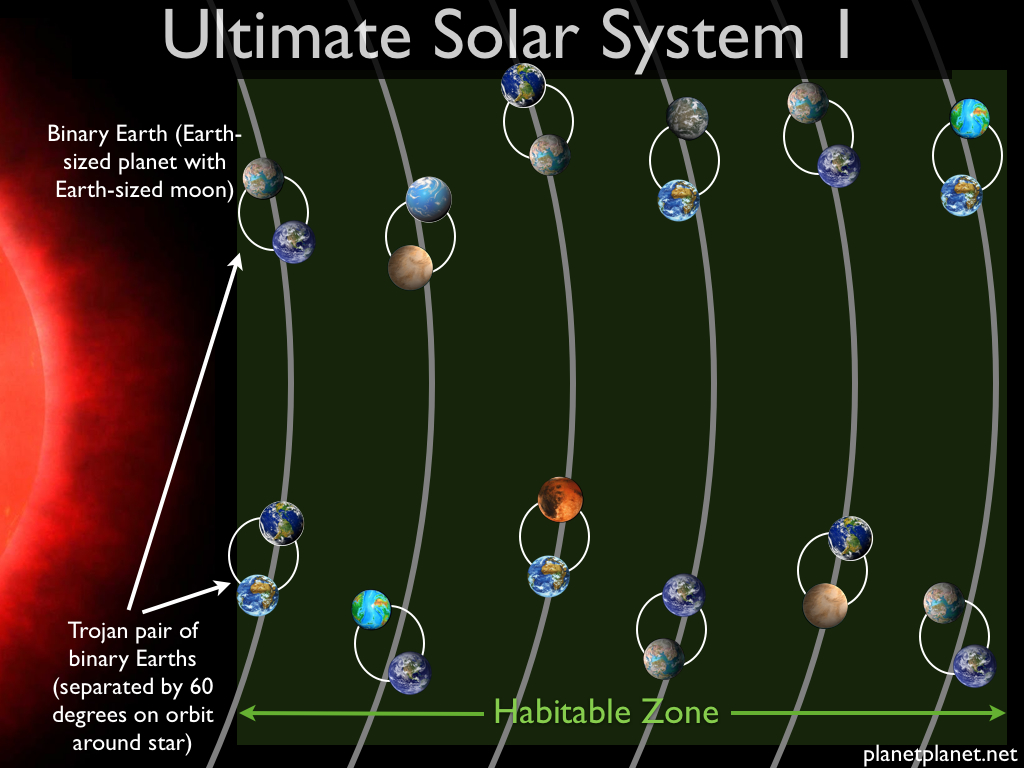Years ago, when the 1970s “Battlestar Galactica” was the pinnacle of TV Sci-Fi in a 10 year old’s imagination, I wondered at the nature of the 12 Colonies of Man, which all seemed to be in the same star system. The old BSG was a bit confused about “star systems” vs “galaxies” so much so that the interstellar nature of the Colonies and their systems had to wait for the 2004 reboot to be made explicit. Yet the idea stuck with me – could a system have 12 habitable planets? I knew about binary and trinary star systems as well as the possibility of Gas Giant moons being habitable (something I imagined as a child, only to have confirmed by the discovery of habitable zone Gas Giants over the last 19 years.)
Then along came “Firefly” and its Verse, which is in a multiple planet, multiple star, yet single system. Dozens of planets! Could that be possible?
Planet-formation Guru, Sean Raymond, has wondered the same thing and has now posted a series of blog-posts which have made the imagining more concretely physics based.
The discussion begins here: Build a better Solar System, a post in which Raymond ponders how our Solar System could be improved by rearranging the known bodies – he concludes we could have 7 habitable ‘planets’ though several would orbit a more Sunwards Jupiter.
Leaving our Solar System behind, he ponders the “Ultimate Solar System”, which squeezes the maximum number of planets into orbit around the best kind of star (an M0-M1 star at about 0.5 Solar Masses probably.)
Ultimate Solar System, Prelude: Building the ultimate Solar System
Ultimate Solar System, Part 1: Building the ultimate Solar System part 1: choosing the right star
As mentioned the right star is an M star, but not one that is too small, as smaller stars mean planets are subject to much higher tidal forces. For example, the strength of tides varies with the inverse cube power of the orbital radius, while the luminosity of stars varies with the 4th-3rd powers. For a 0.5 Solar mass star, the luminosity is about (0.5)^4 = 0.0625 times the Sun, so the habitable radius is at about 0.25 AU, but the tidal forces are ~(0.5)*(1/0.25)^4 times what Earth experiences from the Sun i.e. 32 times stronger. Meaning instead of half metre tides, the planet might get 16 metre tides, though it’d also be rotating slower due to more tidal-braking.
Ultimate Solar System, Part 2: Building the ultimate Solar System part 2: choosing the right planets
Naturally enough, since we’ve picked a long-living star, we want long-living planets – not too small, else they’ll lose their atmospheres. However, since we’re engineering things, selecting a low-EUV activity star will aid in keeping the atmosphere. Another concern is the inexorable decline in geological activity. Bigger planets last longer.
Ultimate Solar System, Part 3: Building the ultimate Solar System part 3: choosing the planets’ orbits
Raymond discusses habitable zone orbits and orbital stability – spaced properly and the system is stable against mutual perturbations for aeons, at least.
Ultimate Solar System, Part 4: Building the ultimate Solar System part 4: two ninja moves — moons and co-orbital planets
This is where the real innovation appears – firstly, twin planets – equal mass planets orbitting each other; then two pairs sharing an orbit 60 degrees apart. This allows 24 planets to be squeezed in, on six mutually stable orbits. Alternatively there could be four Gas Giants in 3/2 resonance orbits, each with five habitable moons, and each Gas Giant with two Trojan pairs in the L4/5 positions, thus 9 habitable planets per orbit for a total of 36.
Ultimate Solar System, Part 5: Building the ultimate Solar System part 5: putting the pieces together
Finally the Ultimate System is a Binary – one with the double Trojan Pairs in six orbits (24 total) and the other with Gas Giants and their retinues of Trojans and Moons – for a Grand Total of 60 habitable planets. The binary stars are at least 100 AU apart, to avoid exciting each other’s systems into too much Chaos. Of course we know of widely separated stellar systems with higher multiplicity. We could have two 100-AU apart binaries, themselves orbitting another binary at a distance of ~2,000 AU. Now that’d be a setting for some cool SF!

